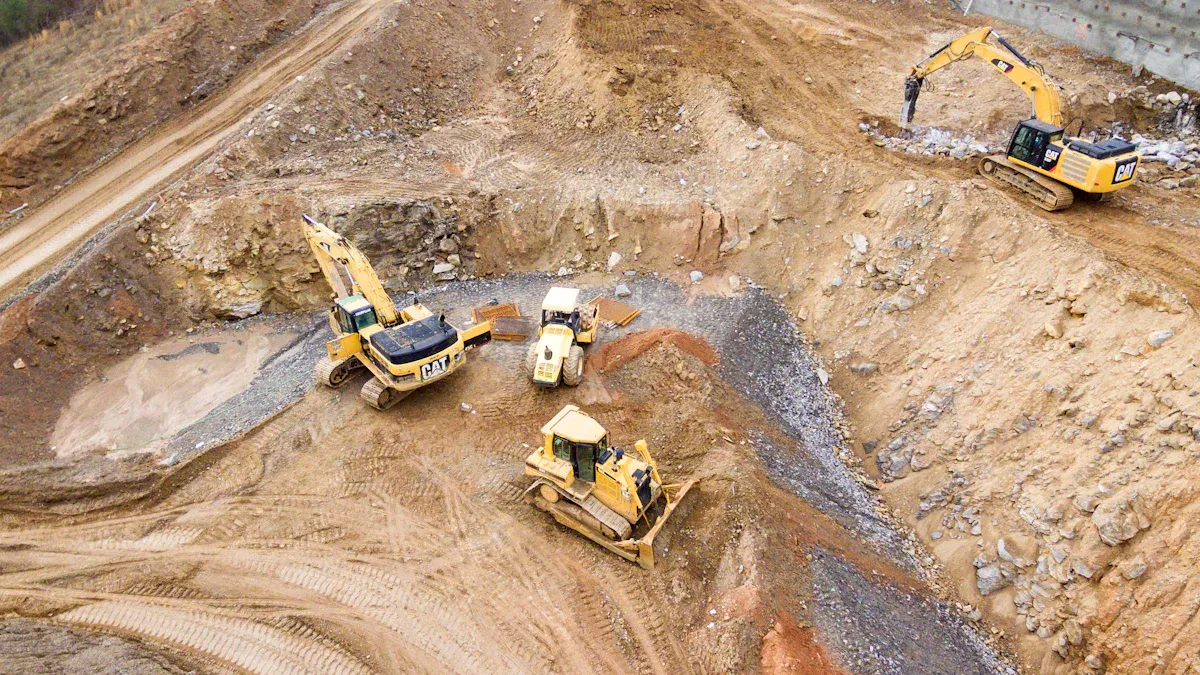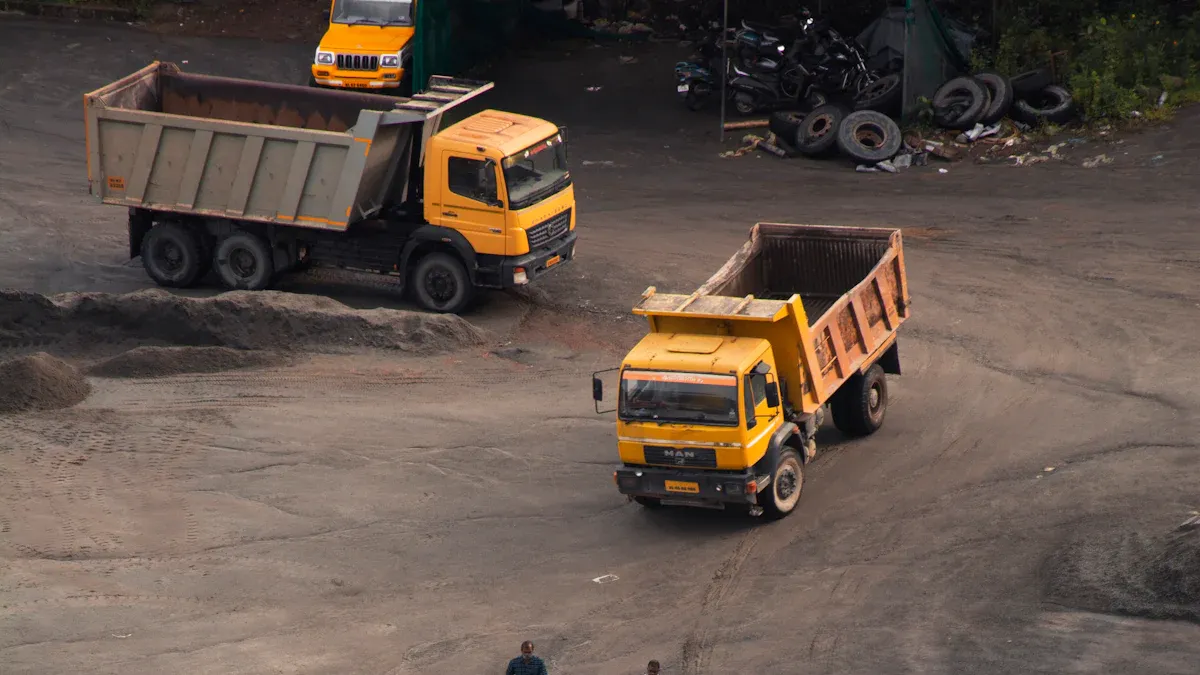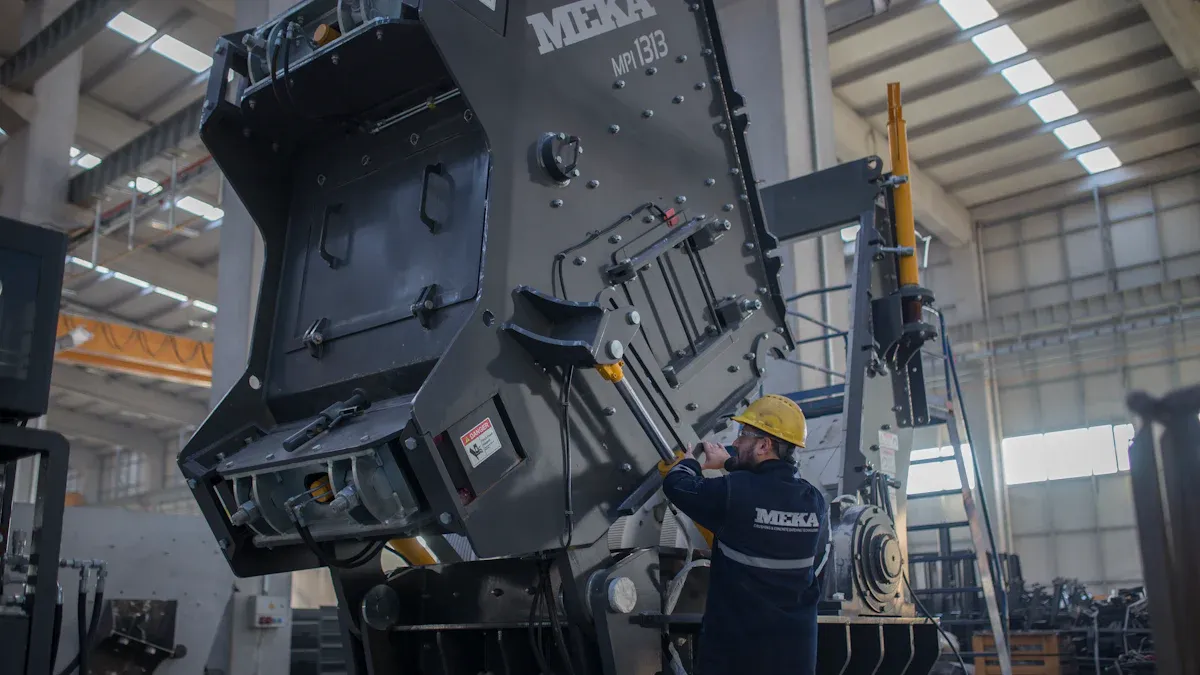
Proper jaw crusher liner replacement is crucial for maintaining the efficiency and longevity of a jaw crusher machine. When executed correctly, this process can lead to significant improvements in operational performance. For instance, using high carbon manganese steel liners as part of the crusher plant parts can increase throughput by 15% and enhance production efficiency by 40%. Additionally, proper replacement techniques for the parts of the crusher machine can extend the service life of components by 2-3 years. Key steps in the replacement process include safely removing old liners, cleaning seating surfaces, and ensuring correct alignment of new jaw crusher machine parts.
Key Takeaways
- Prioritize safety by following established protocols. Use lockout/tagout procedures and wear appropriate personal protective equipment to prevent accidents.
- Thoroughly clean seating surfaces before installing new liners. This step prevents premature wear and ensures optimal contact between the liners and the machine.
- Ensure correct alignment of new liners during installation. Misalignment can lead to uneven wear and increased operational costs.
- Monitor wear patterns regularly. This practice helps determine the optimal replacement schedule and minimizes unnecessary expenses.
- Implement a proactive maintenance strategy. Regular inspections and timely replacements can significantly enhance the lifespan and efficiency of jaw crusher liners.
Pre-Replacement Preparation

Safety Considerations
Before beginning the jaw crusher liner replacement process, safety must be the top priority. Proper safety protocols help prevent accidents and ensure a smooth operation. Here are some essential safety measures to follow:
Safety Protocols
| Safety Protocols | Details |
| — | — |
| Safety Lockout Procedure | Disconnect the power supply and engage mechanical lockout. Release hydraulic pressure (allow at least 5 minutes for bleed time). Install fall protection for access to the crusher pit. |
| Tool & Material Checklist | Use a hydraulic jack with a 50-ton capacity, a torque wrench with a range of 300-800 N·m, and a liner lifting clamp with a safe working load of 2,000 kg. |
| Post-Installation Procedures | Start with a 50% feed rate for the first two hours. Monitor vibration levels, ensuring they remain below 4.5 mm/s RMS. Retorque after eight hours of operation. Record liner serial numbers and measure the initial wear pattern. Update the predictive maintenance schedule accordingly. |
Following these protocols minimizes risks and enhances the overall safety of the replacement process.
Required Tools for Jaw Crusher Liner Replacement
Having the right tools is crucial for an efficient jaw crusher liner replacement. The following list outlines the essential tools recommended by manufacturers:
- Ensure the crusher is stopped and locked out before maintenance.
- Check the weight of the jaw die and ensure lifting equipment is adequate.
- Familiarize yourself with special tools provided for replacing wear parts.
- Clean all jaw die seating surfaces before installation.
- Use the jaw die lifting tool to install the jaw die into the crushing cavity.
- Tighten the center jaw die bolt nuts to remove clearance between wedge retention components.
- Adjust the gap between the lower and upper jaw die to 5 – 8 mm (0.20” – 0.30”).
Additionally, preparing the work area can significantly reduce downtime. Recommended preparatory steps include:
- Shut down the jaw crusher and disconnect its power supply to prevent accidental operation during maintenance.
- Clean the machine thoroughly to remove dust, debris, and leftover material for effective inspection.
- Inspect the crusher for loose bolts, cracks, or visible damage, addressing any minor issues before proceeding.
- Gather all necessary tools and replacement parts in advance to minimize delays.
- Remove worn components carefully using appropriate tools.
- Inspect adjacent parts for wear or damage and replace any that are significantly worn.
- Install new parts, ensuring they align correctly with the machine’s specifications.
- Lubricate moving parts to reduce friction and extend the lifespan of new components.
- Reassemble the crusher and tighten bolts to the manufacturer’s recommended torque settings.
By following these guidelines, operators can ensure a safer and more efficient jaw crusher liner replacement process.
Step-by-Step Jaw Crusher Liner Replacement Process

Removing Old Jaw Crusher Liners
To begin the replacement process, operators must safely remove the old jaw crusher liners. This step is critical to avoid damaging the equipment. Here are the best practices for removing the liners:
- Prepare Before Starting: Ensure all necessary tools and safety equipment are on hand. This includes hard hats, safety goggles, gloves, steel-toed boots, and dust masks.
- Disconnect Power: Disconnect the power supply and apply lockout/tagout devices to prevent accidental operation.
- Inspect Parts: Regularly inspect the components for wear or damage before removal.
- Loosen Bolts: Use a crisscross pattern to loosen the bolts securing the liners. This method helps distribute stress evenly and prevents warping.
- Use Lifting Equipment: Employ appropriate lifting equipment to safely remove the old liners. Ensure the equipment can handle the weight of the liners.
- Inspect Removed Parts: After removal, inspect the old liners for signs of wear or damage. This inspection can provide insights into the operational issues that may need addressing.
- Clean Mounting Surfaces: Thoroughly clean the mounting surfaces to prepare for the new liners.
Using the right tools and personal protective equipment is crucial during this process. Teams should prioritize safety to mitigate risks associated with heavy lifting and equipment handling.
Cleaning Jaw Crusher Seating Surfaces
Cleaning the seating surfaces is vital for ensuring the longevity and performance of the new jaw crusher liners. Proper maintenance of these components prevents dirt or debris buildup, which can lead to excessive wear or even failure. Here are effective cleaning methods:
| Method | Description |
|---|---|
| Abrasive blasting | Utilizes media like aluminum oxide or ceramic to remove contaminants; parameters include grit size and pressure. |
| Wire brushing and grinding | Effective for localized removal of oxide or scale on metals. |
| Alkaline cleaning | Degreases oils and residues using a 1–5% NaOH solution at elevated temperatures. |
| Acid pickling | Removes rust and oxide layers using controlled concentrations of acids; requires neutralization. |
Each method has its advantages, and the choice depends on the specific contaminants present. Operators should ensure that all residues are removed to create a clean surface for the new liners.
Installing New Jaw Crusher Liners
Once the seating surfaces are clean, the next step is to install the new jaw crusher liners. Proper installation techniques are essential for extending the lifespan of the liners. Follow these guidelines:
- Proper Installation and Alignment: Ensure that the liners fit correctly to prevent premature failure. Misalignment can lead to uneven wear and increased operational costs.
- Use of Torque Wrenches: Utilize torque wrenches to achieve the correct bolt tension. This step is crucial for the stability of the liners.
- Check for Seating and Fitment: Liners should sit flush against the seating surfaces. Gaps can lead to wear and damage over time.
- Use of Backing Compound (Epoxy): Applying a backing compound provides additional support and helps maintain the integrity of the liners.
Following these steps will help ensure that the new jaw crusher liners perform optimally and last longer. Operators should also document the installation process for future reference.
Aligning Jaw Crusher Liners Correctly
Correct alignment of jaw crusher liners is essential for optimal performance and longevity. Misalignment can lead to uneven wear, increased operational costs, and potential equipment failure. Operators should follow these steps to ensure proper alignment during installation:
- Check the Manufacturer’s Specifications: Always refer to the manufacturer’s guidelines for specific alignment requirements. Each jaw crusher model may have unique specifications that must be adhered to.
- Use Alignment Tools: Employ specialized alignment tools, such as laser alignment systems or dial indicators. These tools help achieve precise alignment, reducing the risk of misalignment.
- Position the Liners: Carefully position the new jaw crusher liners into the crushing cavity. Ensure that they sit flush against the seating surfaces. Any gaps can lead to premature wear and damage.
- Tighten Bolts in Sequence: When securing the liners, tighten the bolts in a crisscross pattern. This method distributes pressure evenly across the liners, preventing warping and ensuring a snug fit.
- Verify Alignment After Tightening: After tightening, recheck the alignment using the same tools. This step ensures that no movement occurred during the tightening process.
- Monitor During Initial Operation: During the initial run, monitor the jaw crusher closely. Look for any signs of misalignment, such as unusual vibrations or uneven wear patterns. Address any issues immediately to prevent further damage.
Tip: Regularly inspect the alignment of jaw crusher liners during routine maintenance. Early detection of misalignment can save time and costs associated with repairs.
By following these steps, operators can ensure that jaw crusher liners are aligned correctly, maximizing efficiency and extending the lifespan of the equipment.
Post-Installation Procedures
Run-In Period for Jaw Crusher Liners
After installing new jaw crusher liners, operators should observe a run-in period. This phase allows the liners to settle and adapt to the crushing environment. During this time, operators should follow these guidelines:
- Gradual Increase in Load: Start with a reduced feed rate, typically around 50% of the normal capacity. This approach helps the liners adjust without excessive stress.
- Monitor Performance: Keep a close eye on the machine’s performance during the initial hours. Look for any unusual vibrations or sounds that may indicate misalignment or improper installation.
- Check Wear Patterns: Inspect the wear patterns on the liners after the first few hours of operation. This inspection can reveal if the liners are wearing evenly or if adjustments are necessary.
Following these steps during the run-in period can significantly enhance the lifespan of the new jaw crusher liners.
Documentation and Record Keeping
Effective documentation and record-keeping practices play a vital role in maintaining jaw crushers. Operators should implement a systematic approach to track all maintenance activities. Here are some recommended documentation practices:
| Documentation Practice | Details |
|---|---|
| Record time of replacement | Document when the jaw plate was replaced. |
| Model of jaw plate used | Note the specific model of the jaw plate used. |
| Archive information for future reference | Keep records for future maintenance and tracking. |
Regular maintenance and meticulous record keeping contribute to improved maintenance scheduling for jaw crushers. By documenting maintenance activities, inspections, and the condition of wear parts, operators can optimize their maintenance schedules. This proactive approach minimizes downtime and enhances the overall efficiency and lifespan of the equipment.
By adhering to these post-installation procedures, operators can ensure that their jaw crusher liners perform optimally and last longer.
Common Mistakes in Jaw Crusher Liner Replacement
Incorrect Alignment Issues
Incorrect alignment during jaw crusher liner replacement can lead to significant operational problems. Misalignment often results in poor output quality and reduced crushing efficiency. Operators may believe that they can save time by rushing this step, but the consequences can be costly. A survey indicated that improper alignment is one of the most frequently reported mistakes in the industry. This oversight can lead to uneven wear on the liners, increasing the frequency of replacements and maintenance costs.
Inadequate Cleaning Practices
Inadequate cleaning practices before installing new liners can severely impact the performance of the jaw crusher. Dirt and debris on seating surfaces can prevent proper contact between the liners and the machine, leading to premature wear. Operators should prioritize thorough cleaning to ensure optimal performance. Neglecting this step can reduce the lifespan of wear parts by up to 30%. Additionally, using low-grade materials during replacement can accelerate wear and result in unscheduled downtime.
Overlooking Safety Protocols
Overlooking safety protocols during the replacement process poses serious risks. Safety should always be a priority when working with heavy machinery. Failing to follow established safety procedures can lead to accidents and injuries. Operators must ensure that they implement lockout/tagout procedures and wear appropriate personal protective equipment. Ignoring these protocols not only jeopardizes worker safety but can also lead to costly equipment damage.
Tip: Always conduct a safety briefing before starting maintenance work. This practice reinforces the importance of safety and helps prevent accidents.
By avoiding these common mistakes, operators can enhance the reliability and efficiency of their jaw crushers, ultimately leading to better performance and reduced operational costs.
Effectively replacing jaw crusher liners involves several critical steps. Operators must prioritize safety, ensure proper cleaning, and align the new liners accurately. Following these practices can significantly enhance the performance and lifespan of the equipment.
Best Practices Benefits
| Best Practice | Benefit |
|———————————–|————————————————————————|
| Utilize Wear-Resistant Liners | Extends service life of wear parts, reducing frequency of replacements. |
| Implement a Planned Replacement Program | Prevents unplanned downtime and emergency costs. |
| Monitor Wear Patterns | Informs optimal replacement intervals, minimizing unnecessary expenses.
Implementing a proactive maintenance strategy is essential for maximizing the longevity of jaw crusher liners. Regular inspections and timely replacements can lead to reduced downtime and lower repair costs. By investing in a robust maintenance program, operators can ensure their equipment remains efficient and reliable for years to come.
FAQ
What is the typical lifespan of jaw crusher liners?
Jaw crusher liners usually last between 1,000 to 3,000 hours of operation. Factors such as material type, feed size, and operational conditions can affect their lifespan.
How often should jaw crusher liners be replaced?
Operators should replace jaw crusher liners based on wear patterns and performance. Regular inspections every 500 hours can help determine the optimal replacement schedule.
What are the signs of worn jaw crusher liners?
Signs of worn liners include decreased crushing efficiency, increased vibration, and uneven wear patterns. Operators should monitor these indicators closely to prevent further damage.
Can I replace jaw crusher liners myself?
Yes, operators can replace jaw crusher liners themselves if they follow safety protocols and have the right tools. However, consulting with a professional is advisable for complex cases.
What safety gear is necessary during liner replacement?
Essential safety gear includes hard hats, safety goggles, gloves, steel-toed boots, and dust masks. Wearing this equipment minimizes risks during the replacement process.
Post time: Oct-27-2025